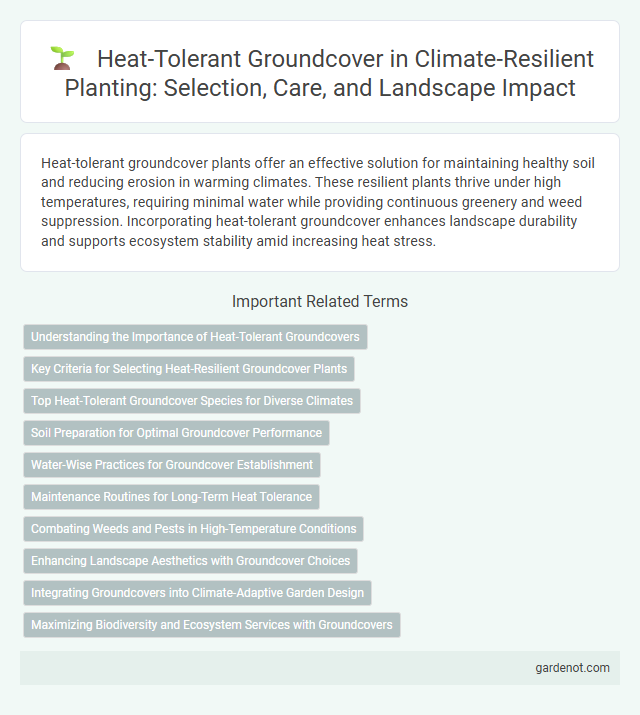Heat-tolerant groundcover plants offer an effective solution for maintaining healthy soil and reducing erosion in warming climates. These resilient plants thrive under high temperatures, requiring minimal water while providing continuous greenery and weed suppression. Incorporating heat-tolerant groundcover enhances landscape durability and supports ecosystem stability amid increasing heat stress.
Understanding the Importance of Heat-Tolerant Groundcovers
Heat-tolerant groundcovers play a crucial role in climate-resilient planting by reducing soil temperatures and minimizing moisture loss during extreme heat conditions. These plants enhance landscape durability, prevent erosion, and support urban heat island mitigation. Selecting species with high heat tolerance, such as drought-resistant succulents and native grasses, is essential for sustainable, low-maintenance green spaces amid rising global temperatures.
Key Criteria for Selecting Heat-Resilient Groundcover Plants
Heat-tolerant groundcover plants must exhibit drought resistance, rapid recovery from heat stress, and the ability to maintain soil moisture under high temperatures. Selecting species with deep root systems and reflective leaf surfaces enhances resilience to extreme heat conditions. Prioritizing plants native to arid or semi-arid regions ensures better adaptation and long-term sustainability in climate-resilient landscaping.
Top Heat-Tolerant Groundcover Species for Diverse Climates
Heat-tolerant groundcover species such as Lantana camara, Blue Rug Juniper (Juniperus horizontalis), and Sedum spp. excel in diverse climates by maintaining soil moisture and reducing surface temperatures. These plants exhibit high tolerance to drought, intense sunlight, and poor soil conditions, making them ideal for climate-resilient landscaping and erosion control. Utilizing native or well-adapted species like Buffalo Grass (Buchloe dactyloides) further enhances ecosystem stability and water conservation in heat-prone environments.
Soil Preparation for Optimal Groundcover Performance
Soil preparation for heat-tolerant groundcover involves enhancing soil structure with organic matter, improving moisture retention to withstand high temperatures. Incorporating well-drained substrates and adjusting pH levels between 6.0 and 7.5 promotes root development and nutrient uptake essential for drought resistance. Proper soil aeration and mulching techniques reduce heat stress and maintain soil temperature stability, ensuring groundcover resilience in extreme heat conditions.
Water-Wise Practices for Groundcover Establishment
Selecting heat-tolerant groundcover species such as creeping thyme, sedum, and buffalo grass enhances climate resilience by reducing water demand during droughts. Implementing water-wise practices like deep, infrequent watering and mulching improves soil moisture retention and promotes strong root development for groundcovers. Using drip irrigation technology further optimizes water use efficiency while establishing groundcover in hot, dry environments.
Maintenance Routines for Long-Term Heat Tolerance
Heat-tolerant groundcovers require consistent maintenance routines such as deep watering during early morning hours to reduce evaporation and stress. Mulching around plants preserves soil moisture and regulates temperature, enhancing the groundcover's resilience to prolonged heat periods. Regular pruning promotes airflow and prevents disease buildup, ensuring long-term vigor and heat tolerance.
Combating Weeds and Pests in High-Temperature Conditions
Heat-tolerant groundcover varieties such as buffalo grass and creeping thyme suppress weeds effectively by forming dense mats that block sunlight, reducing the need for chemical herbicides. These groundcovers enhance soil moisture retention and create microclimates that deter heat-activated pest species like spider mites and aphids. Incorporating drought-resistant plants with natural pest-repellent properties improves ecosystem resilience and lowers maintenance in high-temperature, climate-stressed environments.
Enhancing Landscape Aesthetics with Groundcover Choices
Heat-tolerant groundcovers such as creeping thyme, sedum, and mondo grass improve landscape aesthetics by maintaining vibrant color and texture during extreme heat conditions. These resilient plants reduce soil erosion, suppress weeds, and require minimal irrigation, supporting sustainable garden practices under hotter climates. Strategic selection of drought-resistant groundcovers enhances both the visual appeal and climate resilience of outdoor spaces.
Integrating Groundcovers into Climate-Adaptive Garden Design
Heat-tolerant groundcovers such as creeping thyme, sedum, and native grasses provide essential soil protection and moisture retention in climate-adaptive garden design. Integrating these resilient plants reduces heat stress on soil, minimizes erosion, and conserves water in drought-prone environments. Selecting species with high thermal tolerance supports microclimate regulation and enhances overall garden sustainability in warming regions.
Maximizing Biodiversity and Ecosystem Services with Groundcovers
Heat-tolerant groundcovers such as native sedums and creeping thyme thrive in high temperatures while enhancing soil moisture retention and reducing erosion. These resilient species support pollinators and beneficial insects, maximizing biodiversity and strengthening ecosystem services within climate-resilient landscapes. Integrating diverse groundcovers promotes habitat connectivity, improves soil health, and increases overall landscape resilience against climate stressors.
Heat-tolerant groundcover Infographic

 gardenot.com
gardenot.com